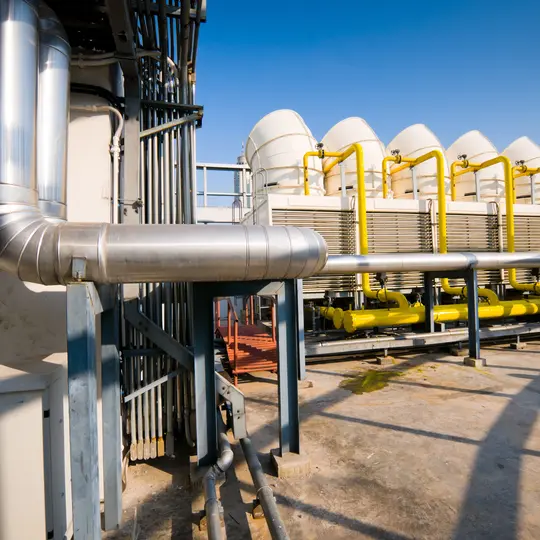Liquid cooling challenges in AI data centers
- By Victor Avelar
- 21 Oct 2025
- 4 min read
As data centers grapple with the intensifying demands of artificial intelligence (AI) and high-performance computing (HPC), direct liquid cooling (DLC) systems have emerged as a leading solution for managing extreme heat densities. While DLC offers unmatched cooling efficiency, its implementation demands careful attention to technical challenges across specification, installation, and operation. This article explores these challenges and provides actionable guidance drawn from the whitepaper Direct Liquid Cooling System Challenges in Data Centers – developed by our Data Center Research and Strategy team.
Why material compatibility matters in AI liquid cooling systems
In DLC systems, incompatible metals can trigger galvanic corrosion, which risks damaging IT equipment. Selecting materials with similar electrochemical properties minimizes corrosion risks.
Balancing liquid and air cooling in AI data centers
Deploying liquid-cooled IT alongside air-cooled systems demands trade-offs between energy efficiency and upfront capital costs. Analysing total cost of ownership can help make these decisions.
Direct coupling complexity
DLC infrastructure connects coolant distribution directly to IT servers, making precision in piping, coolant treatment, and flow control essential to system reliability.
Vendor collaboration for reliable AI liquid cooling operations
Warranty ambiguities and GPU power fluctuations require clear agreements with vendors and robust system monitoring to ensure consistent performance.
DLC specification begins with understanding the materials, architecture, and cooling requirements of liquid-cooled IT systems. The challenges fall into three categories: material compatibility, system integration, and direct coupling complexity.
Challenge I
Material Incompatibility- When metals with differing electrochemical potentials interact in the presence of coolant, galvanic corrosion occurs. This produces debris that clogs cold plate channels and damages IT components—one of the most significant risks in DLC systems.

Challenge II
Balancing Liquid and Air Cooling- Higher coolant temperatures in DLC systems improve energy efficiency but may necessitate a separate chiller plant, increasing upfront capital costs. This creates tension between operational savings and initial investment.

Challenge III
Direct Coupling Complexity- Unlike traditional cooling systems, DLC directly couples servers with cooling infrastructure. Each server requires dedicated piping, connectors, and flow control mechanisms designed for its specific cooling needs, increasing design complexity.

Challenge I
Contamination Prevention- Contamination during installation is one of the most pressing risks to DLC systems. Organic materials like microbes and inorganic particles like metal debris can degrade coolant, clog cold plates, and reduce system efficiency.

Challenge II
Stagnant Coolant Management- Coolant sitting idle in unused feeder lines creates ideal conditions for microbial growth, which can compromise system integrity once the lines become active.

During operation, DLC systems face two primary challenges that require ongoing attention and vendor coordination.
Challenge I
Vendor Warranty Ambiguities- DLC’s direct coupling between servers and cooling systems blurs the lines of responsibility between server vendors, CDU manufacturers, and fluid providers. Misaligned maintenance recommendations and installation defects can lead to disputes and costly delays.

Challenge II
GPU Power Transients- GPUs used for AI workloads often experience power spikes that exceed their thermal design power (TDP), risking overheating. While DLC systems manage steady-state cooling effectively, transient peaks can overwhelm cold plates and lead to GPU throttling or damage.

Liquid cooling success
Direct liquid cooling systems represent a transformative advance in data center cooling efficiency, but success depends on meticulous planning and vendor collaboration. By proactively addressing specification, installation, and operational challenges, stakeholders can realize DLC’s full potential while minimizing risk.
As industry standards evolve, DLC adoption will become smoother, offering a reliable and efficient cooling solution for AI and HPC workloads. The time to act is now. Partner with trusted vendors, implement proven best practices, and position your facility at the forefront of liquid cooling innovation.
Latest in AI & Technology
A cybersecurity blueprint: Securing critical infrastructure through zones of influence
Bridging data and AI for success: Why it matters for businesses
Transforming data center services: AI-driven condition-based maintenance
The looming power crunch: Solutions for data center expansion in an energy-constrained world




